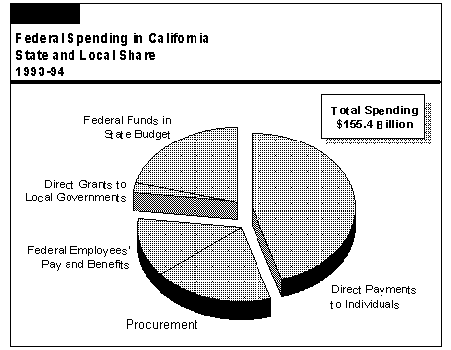
What Role Do Federal Funds Play in the State's Budget, and What Are Some of the Issues Raised by the Current Federal Balanced-Budget Proposals?
Federal spending plays a major role in California. During the 1994 fiscal year, the federal government spent a total of $155 billion in the state--about three times the amount that the state spent from its own funds. About one-fifth of federal spending in California flows through the state budget--an estimated $31.6 billion in 1995-96. More than half of the total support for state health and social services programs comes from federal funds, and additional federal programs outside the state budget help support these programs as well. Federal funds also provide significant funds for transportation and education programs in the state.
Congress and the President have agreed to a goal of balancing the federal budget in seven years. Although their approaches differ significantly, the plans put forward by Congress and the President both involve significant spending cuts compared with current trends. Both plans include reforms designed to slow the growth of spending on health and welfare entitlement programs. Both plans also require significant spending reductions in "discretionary" programs funded through annual budget appropriations--including programs of particular concern to California, such as defense and transportation.
Specific elements of the proposed health and welfare reforms raise particular concerns for California. The President's proposed per-capita spending caps for Medicaid (Medi-Cal in California) would tend to lock in the state's relatively low funding per beneficiary at its current level compared with other states. Alternatively, block grants as proposed by Congress could be less able to accommodate population growth or caseload increases during an economic downturn. California would be more affected than any other state by proposed restrictions on benefits to legal immigrants.
The stalemate between President Clinton and the Congress over the 1996 federal budget and related welfare and health-care reform legislation reflects disagreements over the means of achieving a balanced federal budget. These disagreements have focused on the size of the proposed tax cuts, the corresponding additional spending cuts that would be needed to finance them and the specific nature of the changes that would be made to the major health and welfare programs. However, despite the sharp disagreements that have occurred between the President and the Congressional majority, both the President and Congress have agreed to a goal of balancing the federal budget in seven years--that is, by federal fiscal year (FFY) 2002.
Achieving a balanced budget will require significant changes to federal programs and funding practices. Federal programs and spending play an important role in the state's economy and in the operations and financing of the state and local governments. Consequently, actions to achieve a balanced federal budget are certain to have a significant impact on California.
Achieving a balanced budget would represent a major change from federal budget practices of the last several decades. The federal budget has generated a significant deficit in almost every year since the early 1960s. For the current year (FFY 96), the estimated federal deficit is $154 billion (according to the President's recent 1997 budget proposal)--about 11 percent of total federal revenues of $1.4 trillion.
Federal spending in California totaled $155.4 billion in FFY 94 (the most recent data available) and exceeds the combined own-source revenues of the state and local governments from taxes, fees, and user charges. However, most of this federal spending is outside the state budget. Figure 1 shows that more than three-fourths of federal spending in California in 1993-94 (reflecting 1993-94 state figures and FFY 94 federal data) did not flow through the state budget or go to local governments. The largest component of this "direct" federal spending was for payments to individuals (primarily Social Security and Medicare)--about $71 billion.

Social Security and Medicare Dominate Direct Payments. In FFY 94, Californians received almost $30 billion in Social Security payments for retirement, survivors', or disability insurance benefits. Medicare payments on behalf of Californians totaled $21 billion. Together, these twoprograms accounted for $51 billion of spending--almost a third of total federal expenditures in California. Retirement and disability payments to former federal employees and veterans totaled about $8 billion. Other major payment categories included supplemental security income payments to low-income elderly, blind, or disabled persons ( $3.7 billion, excluding state-funded supplemental payments); food stamps ($2.4 billion); and housing assistance ($2.1 billion).
Military Procurement Still a Significant Factor. Federal procurement and research spending in California totaled about $31 billion in FFY 94 (excluding about $3 billion reflected in the state budget, primarily for contracts with the University of California). The bulk of federal procurement spending was for the military ($22.6 billion, or 77 percent). California accounted for 37 percent of U.S. defense procurement in FFY 94.
Federal Employees' Salaries and Benefits. Spending to pay the salaries and benefits of federal employees in California totaled almost $20 billion in FFY 94. About half of this amount was for Department of Defense military and civilian employees.
To those familiar with California's state budget, federal budget discussions can be confusing because of differences in terminology. Listed below are some of the key budget terms:
The Governor's Budget estimates that the state will spend $31.6 billion of federal funds in the current year. Figure 2 shows how these federal fund expenditures are divided among major programs, and Figure 3 shows the proportion of total funding provided by federal funds for each major program area.
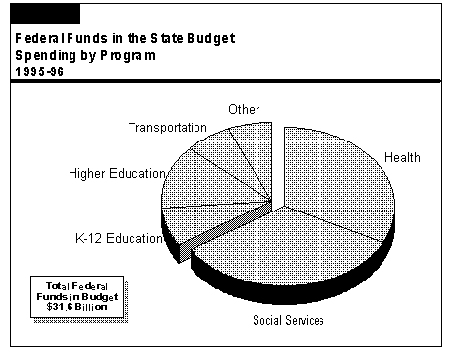
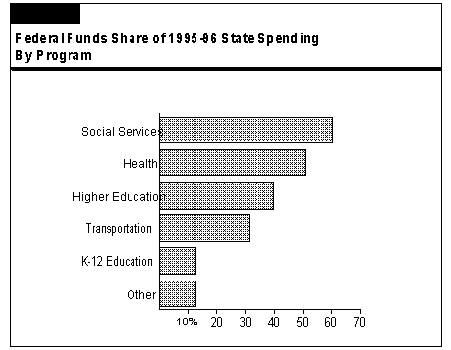
As Figure 2 (page 151) illustrates, two-thirds of the federal funds that the budget estimates that the state will spend in the current year will be for health and social services programs. Of this amount, $10.2 billion is for health programs and $10.6 billion is for social services programs.
Most Federal Health Funding Is for the Medi-Cal Program. The Medi-Cal program receives the bulk of the federal funding for health programs--an estimated $8.9 billion in 1995-96 (including $216 million in assumed reimbursements for emergency health care for illegal immigrants). These funds are provided under the federal Medicaid program, which finances a broad array of health care for low-income persons who qualify for either of the two state/federal welfare programs (AFDC for families with children, and Supplemental Security Income/State Supplementary Program (SSI/SSP) for elderly, blind, or disabled persons) or who are medically needy, but do not meet the financial requirements for the welfare programs.
Overall, federal funds provide half of the total spending in the budget for health programs, as shown in Figure 3 (page 151). However, the Medi-Cal program's reliance on federal funding is greater. The budget estimates that 59 percent of Medi-Cal's spending in 1995-96 will be from federal funds, including the regular 50 percent federal match, disproportionate share hospital (DSH) payments, and reimbursements for illegal immigrant costs.
Social Services Includes Employment and Welfare Funding. In 1995-96, the largest portion of the federal funds that the state will spend will be for social services programs, according to budget estimates. This $10.6 billion of spending is concentrated in the following programs:
Other Program Areas. In addition to health and social services programs, significant amounts of federal funds are received by other programs--particularly education and transportation.
Figure 4 (see page 154) shows the history of state spending from both state funds and federal funds since 1978-79 (the post-Proposition 13 era). Over this period, the general trend has been that the share of overall state spending provided by federal funds has grown moderately--from 30 percent in 1978-79 to an estimated 35 percent in the current year. However, as Figure 4 illustrates, there have been several short-term swings in the federal funds share of state spending within this long-term growth trend.
State spending from federal funds peaked briefly at 33 percent in 1982-83, then declined gradually to a low of 27 percent in 1987-88, and peaked again (at 38 percent) in 1993-94. This pattern follows the course of the state's economy over this period, except that it moves in the opposite direction to these economic cycles (hence the term "countercyclical"). That is, the federal share of state spending increases in response to economic slowdowns and declines during times of strong economic growth. The 1982-83 and 1993-94 peaks in Figure 4 occurred in response to the recessions of 1982 and the early 1990s, respectively. During the late 1980s, California experienced strong economic growth and the federal share of state spending declined.
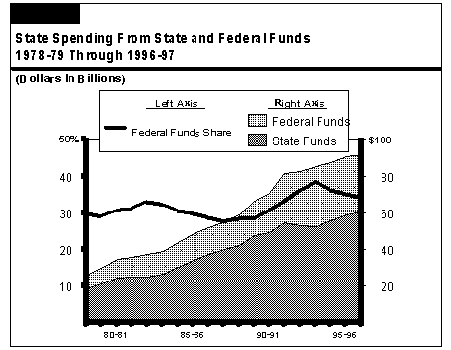
Three factors contribute to the countercyclical behavior of federal funds:
Long-Term Trend Related to Medi-Cal Growth. The long-term increase in the federal funds' share of state spending reflects rapid growth in federal Medicaid funding for the Medi-Cal program. Since 1987-88, federal funding has more than tripled, in part due to the implementation of DSH payments that augment the normal matching program. Federal funding for Medi-Cal would be $4.7 billion less than the current estimate for 1995-96 if it had grown at the same rate that spending from state funds grew since 1987-88.
Legislative proposals by the Congress would fundamentally alter many of the current "safety-net" entitlement programs, such as AFDC, Medicaid, and child welfare services. These programs would be funded through block grants, rather than the current mechanism of providing open-ended matching funds. (States also would be given more discretion over eligibility and benefits in these programs.)
Given the countercyclical role of federal spending, states have been concerned that block grants for safety-net programs, whether at a fixed dollar level or with a modest growth factor, could be inadequate to cover the increased spending that normally occurs in these programs during a recession. In order to address this concern, some of the proposals have included set-aside funds that could be allocated to the states as grants or loans if caseload pressures increase sharply due to recessions or other factors beyond the states' control. Some proposals also would allow states to bank some of their block grant funds each year as a "rainy-day" fund.
Federal funds represent a major share of overall state spending--$31.6 billion in 1995-96 compared with $58.8 billion of spending from the General Fund and state special funds. However, the state has limited flexibility in the use of these funds. Essentially all federal funds are earmarked for specific programs. In most cases, the state's use of federal funds must comply with detailed program requirements and funding allocations. Furthermore, restrictions such as matching requirements and maintenance-of-effort (MOE) provisions, effectively limit the state's flexibility over the use of its own funds in many cases. This is particularly true for health and social services programs, which are most dependent on federal funds. About $12 billion of General Fund spending in these areas (primarily for Medi-Cal and welfare grants) is spent for programs that receive federal matching funds. Of this amount, MOE requirements apply to roughly $10 billion in the current year.
Block Grants Would Not End Restrictions. The block grant proposals for welfare and Medicaid that were passed by the Congress and vetoed by the President would have given the state more flexibility in carrying out these programs--in setting benefit levels and eligibility requirements, for example. However, these proposals still included some of the same types of restrictions that are imposed by existing law, such as MOE provisions, as well as specific service and benefit requirements. The proposals also would have imposed a number of new requirements and restrictions (including targets for work participation by welfare recipients and restrictions on services to legal immigrants).
State budget deliberations naturally tend to focus on those programs funded directly with state funds, but Californians receive services from all levels of government--state, federal, and local. Furthermore, many of these programs are interrelated. Figure 5 lists the major federal programs that have relationships with state programs--including the two largest federal health and human services programs--Social Security and Medicare.
| Figure 5
Major Federally Administered Programs | ||
|---|---|---|
| (In Billions) | ||
| Federal Program | Spending in California | Major Related State Programs |
| Medicare | $21.3 |
|
| Social Security | 29.7 |
|
| Supplemental Security Income | 3.5 |
|
| Food Stamps | 2.4 |
|
| Earned Income Tax Credit | 1.9 |
|
Federal Changes May Require Reevaluation of Related State Programs. Significant funding and policy changes, such as those currently being considered for some of the major federal programs, may necessitate a reevaluation of related state programs. Such a reevaluation may need to address the following issues:
Medicare is a very large program, and changes to it could have significant implications for state programs. The most direct relationship is between Medicare and Medi-Cal. Medicare funds many health services for seniors and some disabled persons, regardless of income level. However, Medicare requires beneficiaries to pay premiums for the nonhospital portion of coverage ("Part B" coverage), make copayments for some services, limits the extent of coverage for some services (such as nursing home care), and excludes certain services. The Medi-Cal program pays costs not covered by Medicare for qualifying low-income elderly or disabled persons. Depending on the income of the qualifying individual, Medi-Cal may pay all or a portion of the costs not covered by Medicare.
For 1996-97, the budget projects that the Medi-Cal program will spend about $1.5 billion out of $6.2 billion from the General Fund to pay Medicare premiums or costs that exceed Medicare coverage. Consequently, changes in Medicare coverage or required premium payments can have a direct impact on state Medi-Cal costs.
Medicare is a major source of funding for hospitals. Medicare "Part A" hospital insurance payments totaled $12.9 billion in California for FFY 94. For this reason, changes in Medicare rules regarding hospital payments could have a significant impact on public hospitals in the state, including the UC teaching hospitals and county hospitals.
Social Security is the largest interrelated program by far, providing almost $30 billion in benefits to Californians in FFY 94. Many low-income individuals receive Social Security benefits, based on employment history. The federal government also administers and funds the Supplemental Security Income SSI program, which provides grants to low-income elderly, blind, and disabled persons. California supplements the SSI payments through the SSP, which is state-funded. The Governor's Budget estimates that the combined cost of the SSI/SSP program in California during the current year will be $5.1 billion, consisting of federal SSI funding of $3.5 billion and state SSP contributions of $1.6 billion.
Social Security and the SSI/SSP programs interact. Social Security benefits help provide a basic income for many elderly or disabled persons. A low-income, elderly, blind, or disabled person can receive both Social Security and SSI/SSP. (The Social Security income offsets the amount of the SSI/SSP grant.)
Because of the linkages between these programs, federal changes in the Social Security or the SSI programs can have a significant impact on the state-funded SSP program. Federal welfare reform proposals currently under discussion would tighten eligibility requirements for the SSI program. This could result in either state savings or costs in the SSP portion of the program, depending on whether the state chooses to continue benefits for newly ineligible individuals. Individuals who lose their SSI eligibility also may shift into other existing state or local programs for which they qualify. For example, excluding certain disabled children from SSI could result in shifting them to the AFDC program. In other cases, exclusion of noncitizens from SSI could shift individuals onto county general assistance rolls.
Several other major federal programs have important linkages and interrelationships with state and local welfare and social services programs.
Food Stamps. Although county welfare offices operate the food stamp program, food stamps themselves are funded directly by the federal government, which also establishes the eligibility requirements and rules for the program. In FFY 94, the cost of food stamps distributed in California was $2.4 billion. The food stamp program interacts with many other programs, including AFDC, child nutrition, and senior nutrition programs, and county general assistance. For example, AFDC recipients receive food stamps. And, generally, if a person's AFDC grant is reduced, the amount of food stamps goes up.
Earned Income Tax Credit. The Earned Income Tax Credit (EITC) provides a tax credit to working families with low or moderate incomes. The credit is refundable, so that qualifying families receive the full amount of the credit even if it exceeds their tax liability. For FFY 94, the amount of these "excess" credits in California was $1.9 billion. Families on welfare with earned income can receive the EITC. Consequently, changes in eligibility for, or the amount of, the EITC can affect the total income available to working welfare recipients, and may also increase or decrease work incentives for welfare recipients.The same is true for other tax proposals that affect families, such as a per-child tax credit.
In November 1995, Congress passed the Balanced Budget Act of 1995 (H.R. 2491), which included substantial changes to entitlement programs such as Medicare, Medicaid, AFDC, and SSI, along with significant tax reductions as part of a plan to balance the federal budget by FFY 2002. The President vetoed this measure based on differences with the Congress over the size of the spending and tax reductions in the plan and on policy differences with Congress over many of the specific changes to programs that were made by the Balanced Budget Act, particularly with respect to the health and welfare entitlement programs.
On February 6 , 1996, President Clinton submitted the outline of his FFY 97 budget proposal to Congress (detailed proposals were deferred until March 18 due to continued uncertainty over the FFY 96 budget). The President's budget also includes a plan to balance the federal budget by FFY 2002, using the economic and baseline budget projections of the Congressional Budget Office (CBO). Balance would be achieved a year sooner under the slightly more optimistic economic assumptions of the Office of Management and Budget (OMB).
The President's plan has smaller spending and tax cuts than the Congressional plan. It spends $306 billion more and generates $187 billion more in revenues over the seven-year period (including FFY 96) than the Congressional plan (as scored by CBO). Both plans increase the federal debt because they continue annual deficits (although in declining amounts) until they reach balance. The Congressional plan would have increased the debt by $638 billion, while the President's plan increases the debt by $755 billion.
A number of other plans, or major elements of plans, also have been under discussion. In particular, these include the so-called "Blue-Dog" plan by a group of conservative Democrats in Congress (which has no tax cut); and more recently, a proposal for welfare and Medicaid reform adopted by the National Governor's Association.
The federal budget process divides the budget into two components--mandatory and discretionary--and both the President's and Congress' plans to balance the budget reflect this two-part structure.
Mandatory programs are those in which ongoing law controls spending. Entitlement programs, such as Social Security, Medicare, Medicaid, AFDC, and SSI are all mandatory programs. Spending for these programs is not established in the annual appropriations bills. Instead, changes in mandatory programs' spending or revenues must be made by amending the laws that establish the programs--changing benefit levels or eligibility, for example. Most mandatory program changes needed to meet Congress' budget objectives usually are included in an annual omnibus budget reconciliation bill (similar to the budget trailer bills that have become part of California's state budget process).
Discretionary programs and functions depend on annual appropriations for funding. Defense is the largest of the discretionary programs, but the operating budgets of most federal departments--along with a host of individual programs in areas such as job training, education, social services, community development, and the environment--are included in discretionary spending. The discretionary category also includes transportation funding.
The largest share of spending in the federal budget is for mandatory programs. The President's budget estimates that mandatory spending in FFY 96 will total $793 billion, compared with discretionary spending of $539 billion. In addition, spending in FFY 96 will include $243 billion for net interest costs on the debt (which is treated as a separate program).
Budget Enforcement: Pay-as-You-Go and Spending Limits. Reducing the federal deficit has been a concern for some time, and Congress has established a process for setting budget targets and then monitoring and controlling its fiscal decisions. Under this process, mandatory and discretionary programs are subject to different control mechanisms. Changes in mandatory spending (or taxes) are subject to a pay-as-you-go (PAYGO) rule. Thus, any law change that is expected to increase costs (such as raising benefit levels or expanding eligibility) or reduce tax revenues relative to budget targets must be offset by savings (or revenue increases) from other changes in the law. Discretionary spending, on the other hand, is subject to an overall annual dollar limit. Current law freezes discretionary spending through FFY 98.
Debate Tends to Focus on Mandatory Programs. The balanced budget plans reflect this difference between the two types of programs. For mandatory programs and taxes, the budget plans propose specific future savings by program or specific tax changes, and the plans include many proposals for legislative changes to achieve those goals. Consequently, the budget debate tends to focus on changes in mandatory programs, not only because they are very large and important, but also because policy changes in them are more explicit. In contrast, the budget plans simply apply overall dollar limits to future discretionary spending without designating individual amounts by program (except in appropriations for the budget year). Consequently, the plans defer program and policy decisions for discretionary programs.
Figure 6 (see page 162) illustrates spending for mandatory and discretionary programs under each of the two budget-balancing plans through 2002 compared with CBO's December baseline spending estimates. The spending figures are presented in constant (that is inflation-adjusted) 1996 dollars. The spending amounts shown for the Congressional Plan are from CBO's December 1995 Budget Update and reflect the estimated savings that would have been achieved had the Balanced Budget Act been signed in November 1995.
Common Features. Both plans (and the CBO baseline) have several features in common:
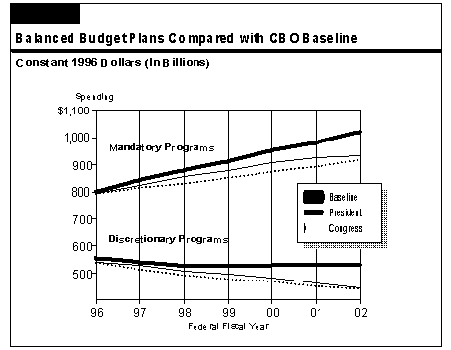
Major Differences. The plans differ in their overall fiscal approach in several major ways:
Over the next decade or so, the federal budget benefits from a demographic boost. Baby Boomers' Social Security contributions are generating significant and growing surpluses in the Social Security Trust Fund, which offsets a portion of the deficit. Around the year 2010, as the Baby Boomers begin to retire and draw on the trust fund, this effect will begin to reverse. Medicare and Medicaid costs also will increase with the aging of the Baby Boomers. Although they slow spending growth and decrease in the size of this eventual problem, neither the President's plan nor the Congressional plan address this longer-term issue.
The balanced-budget plans raise a host of fiscal and policy issues for the nation as a whole, but several general issues have particular importance for California. Figure 7 highlights some of these issues that we have identified.
| Figure 7 California Concerns Raised by Balanced Budget Plans |
|||
|---|---|---|---|
| Medicaid per-capita cap proposal could freeze state at current low spending levels per beneficiary. | ||
| Block grants may not adjust for greater population growth in California than in the rest of the nation. | ||
| Immigrant restrictions would have disproportionate impact in California. | ||
| Potential for discretionary spending cuts in defense and transportation would have a significant impact on California than other states. | ||
Medicaid Per-Capita Costs. California's Medi-Cal program is very large, but it spends much less per beneficiary than many other state Medicaid programs. In general, freezing spending per beneficiary--the approach taken in the President's Medicaid proposal--would lock in this disparity.
Block Grants and Population Growth. Projections indicate that California's population will continue to grow faster than that of the rest of the nation. For this reason, converting Medicaid and welfare programs from entitlement to block grant funding, as the Congressional plan would, could be more constraining to California than to other states. However, the level of the proposed block grants, as well as other features of the proposal (such as growth factors), also have to be considered.
Immigrant Restrictions. California has more immigrants than any other state, so proposals to limit or eliminate benefits and services to immigrants would have a disproportionately large impact on the state. Both balanced-budget plans tighten up eligibility criteria for legal immigrants. However, the Congressional plan is much more restrictive, and would affect many immigrants who already live in the state, as well as prospective immigrants into California. On the other hand, both proposals provide additional funds to the state for costs related to illegal immigrants. The proposals affecting immigrants should be evaluated to determine the extent to which they will shift costs from the federal government to the state or local governments.
Discretionary Spending Cuts. The deep reductions proposed for discretionary spending could have particularly important implications for California. The largest component of discretionary spending is for defense and, despite recent cutbacks, defense spending continues to be proportionately larger in California than in the rest of the nation. California has extensive needs for infrastructure improvements, particularly in transportation. Federal funding for these purposes also could be affected by discretionary spending cuts.
As discussed in Part I of this volume, the current federal budget stalemate has delayed federal actions needed to achieve savings assumed in the state's budget. Furthermore, the continuing resolutions under which the federal government has been operating could result in additional funding shortfalls. Ultimately, however, the federal budget stalemate will end and it appears likely that some form of balanced-budget plan will be adopted, which would have important and lasting effects on the state's budget, programs, and residents.
Return to LAO Home Page